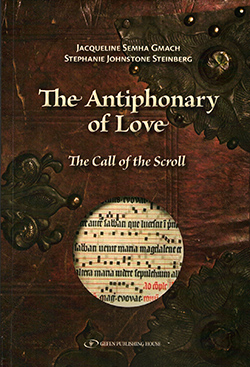The Antiphonary of Love: The Call of the Scroll by Jacqueline Semha Gmach and Stephanie Johnstone Steeinberg; Jerusalem: Gefen Publishing House © 2022; ISBN 9789657-023648; $16.95.
antiphonary (n) A collection of Gregorian chants intended for use by a liturgical choir.

 SAN DIEGO – This book is a fictionalized account of Jacqueline Semha Gmach’s life in Tunisia and Canada before settling in San Diego where her store of cultural knowledge for many years defined programming at the Lawrence Family JCC. It is also a love story, travelogue, and collection of photos that are dear to Gmach.
SAN DIEGO – This book is a fictionalized account of Jacqueline Semha Gmach’s life in Tunisia and Canada before settling in San Diego where her store of cultural knowledge for many years defined programming at the Lawrence Family JCC. It is also a love story, travelogue, and collection of photos that are dear to Gmach.
It begins in Tunisia when a pre-teen girl, Yafifia, finds a scroll inside a jar amid the widely scattered ruins of ancient Carthage. Although she is aware that it is illegal to remove anything from the historic site, she does so anyway — hiding the scroll away from her parents lest they get in trouble for her actions.
Her idyllic childhood, during which French-speaking Christian, Muslim, and Jewish children play happily together, becomes increasingly troubled as rising nationalism in predominantly Muslim Tunisia makes Jewish families more and more fearful for their safety. Yafifia’s parents decide to move to Montreal, where citizens, as in Tunisia, speak French (as well as English). With severe misgivings, Yafifia smuggles the scroll out of the country.
After growing to become a college student, Yafifia meets Gregory, to whom she is instantly attracted. It turns out that he is a student of antiquities. When she describes the scroll to him, he guesses correctly that it is a page from an antiphonary, a book of Gregorian chants.
As they seek to learn more about the scroll – its music, illustrations, and age – they set off on an adventure together which, as the book title suggests, leads to their falling in love. However, he is Ashkenazic, and she is Sephardic and deeply rooted to her traditions.
I’ll leave the story of their romance there, lest I be accused of being a spoiler. There is much elsewhere in the book to learn. Coauthors Gmach and Steinberg describe the sites of Paris and of Israel (to which Yafifia takes a trip to learn more about the scroll), and there is a wonderful section of art and contemporary photography inserted in the book as the story approaches its denouement.
This is the second enjoyable book by Gmach in which she tells of life in mid-20th century Tunisia—the previous being her memoir From Bomboloni to Bagel: A Story of Two Worlds, which was reviewed on this site in 2014.
*
Donald H. Harrison is editor emeritus of San Diego Jewish World. He may be contacted via donald.harrison@sdjewishworld.com